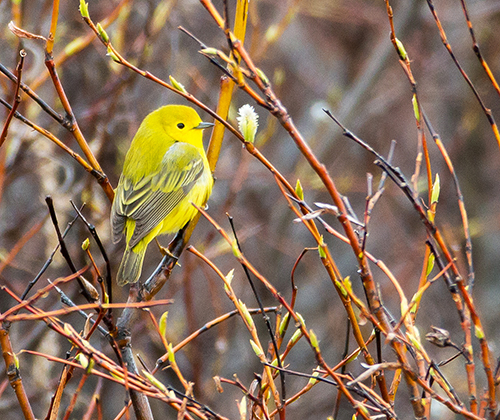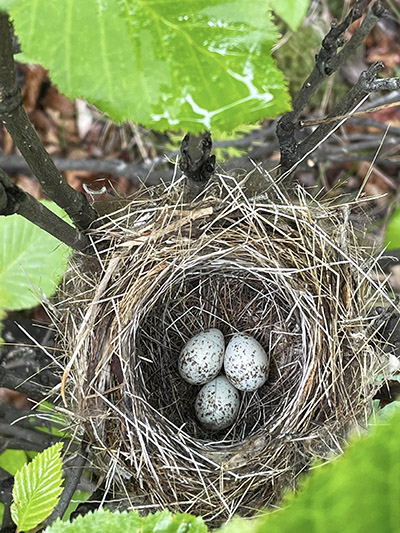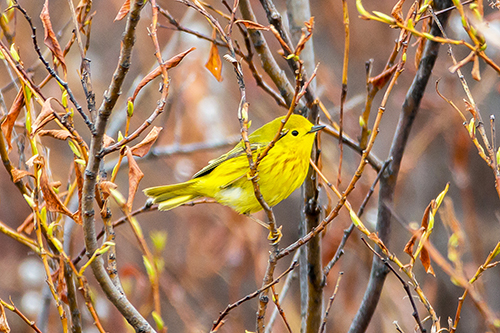Alaska Fish & Wildlife News
July 2023
Alaska’s vibrant yellow tropical migrants

My fascination with striking yellow birds goes back to my student days in Southeast England. I remember one morning looking bleary-eyed out my dorm window and seeing a flock of exotic yellow-green parakeets clustered in a tree, usually occupied by subtler-colored pigeons or sparrows. It turned out that they were escapees, former pets turned wild. In the wonderful way that life can be so adaptable, they adjusted to life in Surrey, England.
There’s something remarkable about a bird that doesn’t blend into the environment. As a teenager I used to spend a few weeks in the summer in Malaysia, and I expected that sort of thing in the tropics. Imagine my surprise, then, when I encountered lemony-feathered birds along the banks of the Matanuska River in Palmer. These birds were migrants, summer visitors to our vast frontier.
I was walking with a friend and incidentally birding. I was expecting to see birds like bald eagles or chickadees. What I did not expect was a sunburst of cheerful color as the flock fluttered from one area of sand to another. When binoculars failed to clue us into what they were, I spent the better half of an hour trying to capture them on camera. I tried to surreptitiously scurry around in a sort of hunched stance, keeping distance so as not to startle them and respect their space, while also trying desperately to snap at least one good photo. The little birds kept fluttering. All my photos were inevitably blurry by my inexpertise.
I know a little more about them now; namely, that they’re called yellow warblers, and that they’re marvels.
You could call them lemon-shaped; they taper on both ends. Their heads and bellies are a vibrant yellow, with rusty brushes along the breast and darker streaks of green throughout their wings and tails. Females are uniformly yellow on their chests, missing the ruddy streaks found on males. Their beaks are long and pointed; their eyes, beady and black. Around 5 inches long (12.7 centimeters), they’re about the size of two lemons end to end, their wingspans are longer than that still, somewhere between 6.5 to 8 inches (16-to-20 centimeters). They weigh much less than your average lemon, coming in at a colossal half an ounce (9 to 11 grams). They are brilliant and beautiful.

Turns out, they weren’t sitting still for the camera because they forage endlessly. Agile and quick, they flutter along small branches and twigs seeking out caterpillars, insects and insect larvae. What made things harder still was their preference for shrubby thickets and woods, which meant that there was a lot of greenery and branches in the way of the lens. And, really, shrubby thickets are where they find mayflies, moths, mosquitoes, beetles, damselflies, spiders, among other delicacies. They snatch insects from twigs and foliage, and flutter and hover to seek out snacks from the underside of leaves, before darting after insects taking flight.
You can at least hear them by their distinctive call, which is rather apt for their sweet appearance– “sweet, sweet, sweet, I’m so sweet”. The call is rapid, with 6-10 quick whistles, made by both males and females of the species. Males guard territory by singing or by intimidating (and yellow) displays of flight. Their nests might be found in the secure fork of a bush or a small tree such as willow. Nests are constructed by female yellow warblers over about four days, composed of a cup of grasses, bark strips, and plants, and reinforced on the outside by plant fibers, spiderwebs, and softer fibers such as seed heads of dandelions. For the inner cup of the nest, materials like moose hair, feathers, and soft fibers are favored – gathered, or stolen from other nests.
In our realm of North America, yellow warblers don’t have to contend with cowbirds. Cowbirds are not a species of bird we see in Alaska; parasitic in nature much like cuckoos, they lay their eggs in the nests of birds like yellow warblers. Yellow warblers confound these efforts by building a nest atop the cowbird eggs and laying their eggs on top. In Alaska, perhaps, they can rest easy knowing their eggs are safe from at least this one particular threat.

You won’t see them year-round; they visit us in the north to nest in the summer, wintering in more temperate climes as far south as Central and South America, trading taiga for mangrove forests. An interesting detail regarding where they chose to spend summer and winter: a study from UC Davis in 2021 showed that these bright birds prefer similar climates in their wintering and summering areas. Individual birds show preferences for drier or wetter areas, but not for warmer or cooler areas. Birds that breed in relatively dry parts of North America overwinter in dry parts of South or Central America.
An earlier study by Rachael Bay and colleagues published in Science found links between genetic variation and precipitation across North America, suggesting that certain individuals may be adapted to dry conditions while others thrive in wet conditions. The UC Davis researchers built on this, using genetics to predict where birds captured on their wintering grounds in Central and South America would end up breeding by comparing climate patterns in their winter and summer areas.
Yellow warblers are not endangered. They are adaptable and resilient, which makes them all the more an indicator of the wellness of our environment.
Links
Genomic signals of selection predict climate-driven population declines in a migratory bird
Subscribe to be notified about new issues
Receive a monthly notice about new issues and articles.
